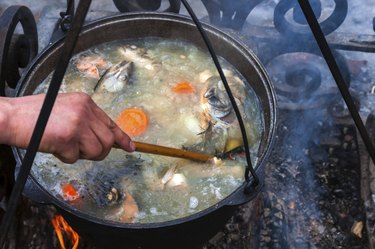
Prior to industrialization and the development of commercial food processing, typical American families prepared simple meals, from scratch, at home. In the early 1900s, there were no fast food chains or frozen TV dinners. When planning a 1908 menu, you were limited to what was readily available in your garden, cellar or icebox -- or at the nearest general store, which could be several miles away.
Meats, Fish and Poultry
Video of the Day
In the early 1900s, the United States was vastly agricultural and many families lived off the land, cultivating their own vegetable and herb gardens and raising their own livestock and poultry. Hunting and fishing provided wild game and other meat alternatives. Meat was a mainstay of the 1908 American diet. Culinary researcher Lynne Olver lists veal, steak, roast beef, hamburger, ham, oysters, clams, flounder, mackerel, codfish and shad as typical spring menu items.
Video of the Day
Fruits and Vegetables
Back in the day, fresh markets were not as easily accessible as they are now. The typical family ate home-grown, seasonal fruits and vegetables, unless they had the foresight to "put up" some of their previous year's crop. Had you lived in 1908, you would have eaten potatoes, of some variety, at least once a day. You might also have enjoyed tomatoes, lettuce, carrots, turnips, beets or asparagus. Fruits were less abundant in many areas of the country. Apples, cherries, plums, pears, melons and citrus fruits were, generally, reserved for breakfast and desserts.
Milk and Dairy Foods
Milk and dairy foods weren't the focus of the American diet circa 1908, as it was difficult to prevent spoilage. It wasn't until the 1930s that the average American family owned an electric refrigerator. Until then, you stored cold foods, outside, in a well or spring house, or indoors in an "icebox" -- basically, a cabinet filled with manufactured ice. You used canned milk, rather than fresh, for cooking.
Grains
In the 1900s, bread-making was part of the daily routine in American households. Whole grain cereals were year-round breakfast staples. Americans of that era, unaware that too much of a good thing could be harmful, were much taken with sweets. In 1908, you would have treated your family to homemade muffins, cakes and pies, or bought them at the local bakery.
Diet Considerations
Minus the convenience of electric appliances, making a meal was no easy feat in 1908. You cooked everything in heavy, cast iron pots -- either on the hearth or on a wood cook stove -- and it was time consuming. On hot summer days, you probably cooked foods outside, over an open fire, since there were no electric fans or air conditioning. City dwellers had greater access to restaurants featuring the native cuisine of immigrants; the first pizzeria opened in New York City in 1905. In addition to residence, your ethnicity, religious background and economic status influenced what and where you ate.
- Food Timeline: "FAQs: Popular 20th Century American Foods"; Lynne Olver; May 2011
- Library of Congress: Who “Invented” the TV dinner?; August 2010
- "Time" magazine: Business: The First Refrigerators; August 13, 1945
- "Refrigeration and Air Conditioning Technology"; W.C. Whitman et al.; 2005
- University of Florida: "The Great North American Diet, Consequences and Agribusiness"; L. Elortondo et al.; 2005
- "Food Review"; American Cuisine in the Twentieth Century; L.K. Dyson; January 2000